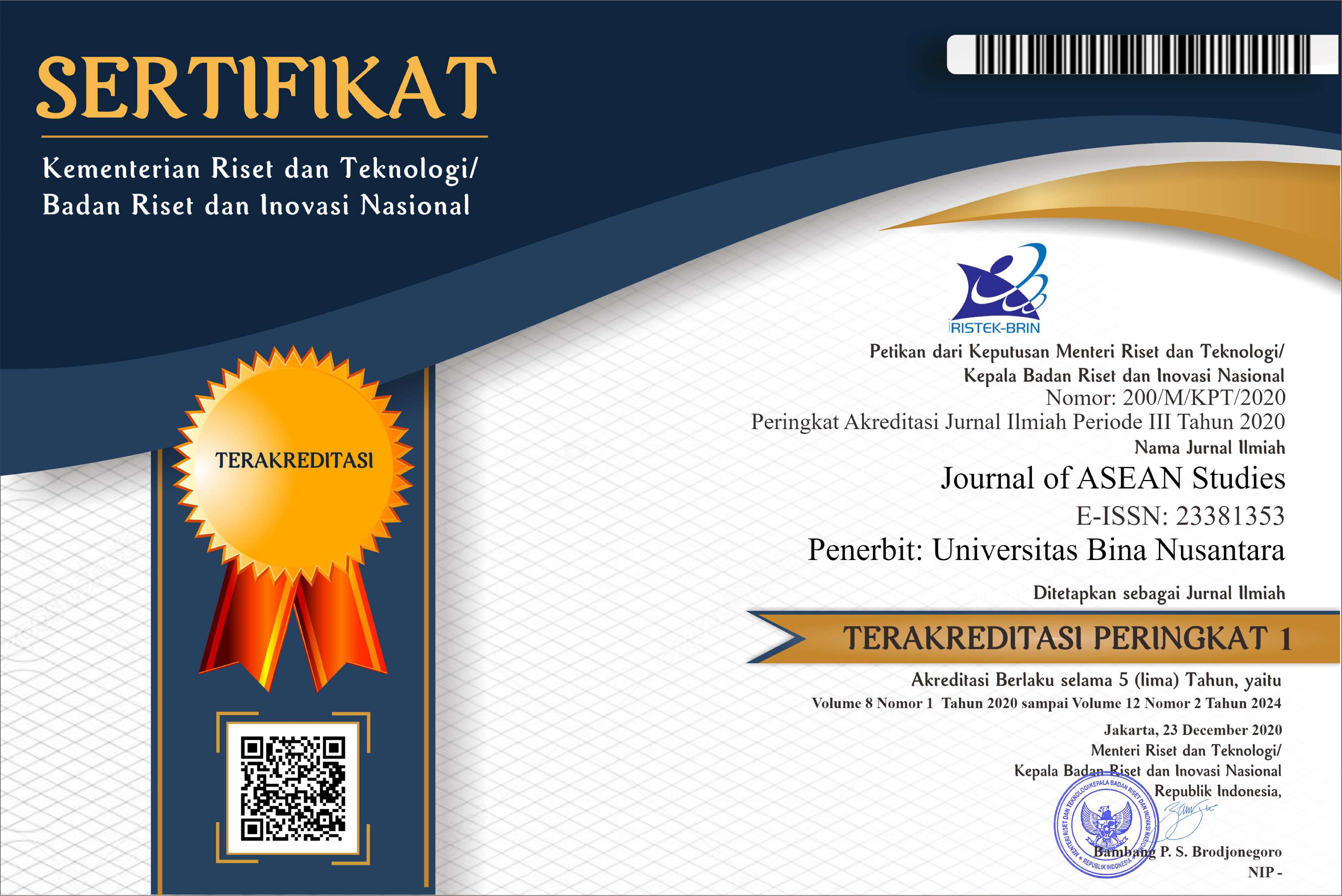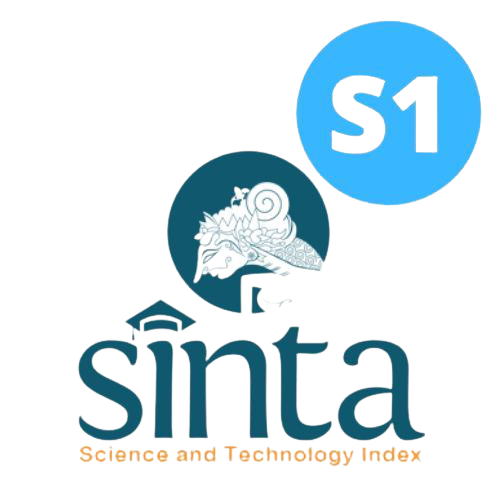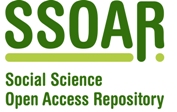Sub-National Government and the Problem of Unequal Development in ASEAN Economic Integration: Case of Indonesia
DOI:
https://doi.org/10.21512/jas.v5i1.2060Keywords:
ASEAN, Indonesia, development gap, sub-national governmentAbstract
Economic integration, as a prevalent phenomenon in contemporary international relations, brings with it several problems including in the practice of development. Krapohl & Fink (2013) argue that regional integration can follow three different developmental paths which are intra-regional interdependence, extra-regional dependence and intra-regional asymmetries and hence regional integration can actually reinforce current situations rather than changing it. With regards to this, ASEAN is following the second path, creating a reliance on external actors and thus requiring member states to be highly competitive in the global level. However, this strategy ignores an important element, the intra-national development gap, since ASEAN is mostly focused in overcoming the intra-regional gap. This paper therefore seeks to elaborate the problem of increasing intra-national development gap due to regional integration by using Indonesia as a case study. The findings show that regional integration in Indonesia can actually widen the national development gap due to three main reasons. First, ASEAN integration is highly top-down in nature, thus limiting the role of Indonesia’s sub-national governments (SNGs) and private actors in the process; second, differing capacity of Indonesia’s sub-national governments to engage in IR provides higher opportunities for some while creating hindrances for others and lastly, the high transactional cost of intra-national economic activities in Indonesia causes the benefits of economic integration to be highly concentrated in one area. Therefore, there needs to be a larger role for SNGs in regional integration particularly in the most underpriviliged area of Indonesia.
Plum Analytics
References
REFERENCES
• Abugattas, L. 2004. Swimming in the Spaghetti Bowl: Challenges for Developing Countries under the New Regionalism. Policy issues in International Trade and Commodities Study Series, No. 27. United Nations: New York and Geneva
• Antique & Rini, E. 2009. ‘Otonomi Daerah Picu Pertumbuhan Daerah Turun’ in Vivanews. Retrieved October 24, 2015 from http://bisnis.news.viva.co.id/news/read/82675/otonomi_daerah_picu_pertumbuhan_daerah_turun
• Association of Southeast Asian Nations Seretariat. 2014. ASEAN Statistical Yearbook 2014. Jakarta. ASEAN Secretariat
• Badan Pusat Statistik. 2015. Foreign Direct Investment Realization by Province. Retrieved October 25, 2015 from http://www.bps.go.id/linkTabelStatis/view/id/1337
• Balaam, D.N & Dillman, B, 2011, “Introduction to International Political Economy”, 5th Edition (International Edition), Pearson
• Beeson, M. 2013. “Living with Giants: ASEAN and the Evolution of ASEAN Regionalism” in Trans-Regional and National Studies of Southeast Asia Vol. 1 Issue 2
• Carbaugh, R, 2005, International Economics, South Western
• Gavin, B, 2005, Reconciling Regionalism and Multilateralism Toward Multilevel Governance, United Nation University CRIS Occasional Papers
• Gibson, R. 2011. A Primer on Collaborative Multilevel Governance. Canadian Regional Development
• Guido, B. & Kamarulnizam A. 2011. ‘Indonesian Perceptions and Attitudes toward the ASEAN Community’ in Journal of Current Southeast Asian Affairs, 30, 1, 39-67. ISSN: 1868-4882 (online), ISSN: 1868-1034 (print)
• Hill, H & Menon, J. 2010. ‘ASEAN Economic Integration: Features, Fulfillments, Failures and the Future’ ADBI Working Paper Series on Regional Economic Integration No. 69
• Hooghe, L & Marks, G, 2002, ‘Types of Multilevel Governance’ in Les Cahiers Europeens de Sciences Po, No. 03. Paris: Centre D’etudes Europennes at Sciences Po
• Krapohl, S & Fink, S. 2013. “Different Paths of Regional Integration: Trade Networks and Regional Institution-Building in Europe, Southeast Asia and Southern Africa” in Journal of Common Market Studies Vol. 51, Issue 3
• Ministry of Trade, Republic of Indonesia. 2015. Growth of Non-Oil and Gas Export: Provincial Period 2010-2015. Retrieved October 25, 2015 from http://www.kemendag.go.id/en/economic-profile/indonesia-export-import/growth-of-non-oil-and-gas-export-provincial
• Pambudy, N.M. 2011. Menguatkan Degup Jantung Ekonomi in Kompas. Retreieved October 25, 2015 from http://megapolitan.kompas.com/read/2011/03/04/02490645/twitter.com
• The Asia Foundation. 2008. Biaya Transportasi Barang Angkutan, Regulasi dan Pungutan Jalan di Indonesia. Retrieved October 24, 2015 from https://asiafoundation.org/resources/pdfs/movinggoodslightbahasa.pdf
• The World Bank. 2014a. Reducing Inequality in Indonesia. Retrieved October 24, 2015 from http://www.worldbank.org/en/country/indonesia/brief/reducing-inequality-in-indonesia
• The World Bank. 2014b. Mempercepat Pergerakan Container di Pelabuhan Utama Indonesia. Retrieved October 25, 2015 from http://www.worldbank.org/in/news/feature/2014/02/19/moving-cargo-faster-in-indonesia-main-sea-port
• United Nations Conference on Trade and Development. 2007. Trade and Development Report: Regional Cooperation for Development. Retrieved October 25, 2015 from http://unctad.org/en/docs/tdr2007_en.pdf
• World Trade Organization. 2015. List of All Regional Trade Agreements. Retrieved October 25, 2015 from http://rtais.wto.org/UI/PublicAllRTAList.aspx
• Wunderlich, J.U. 2012. “Comparing Regional Organization in Global Multilateral Institutions: ASEAN, the EU and the UN”




















